盐度胁迫对三疣梭子蟹肌肉和血淋巴中游离氨基酸含量的影响
低盐胁迫对三疣梭子蟹鳃和肝胰腺显微结构及家系存活的影响
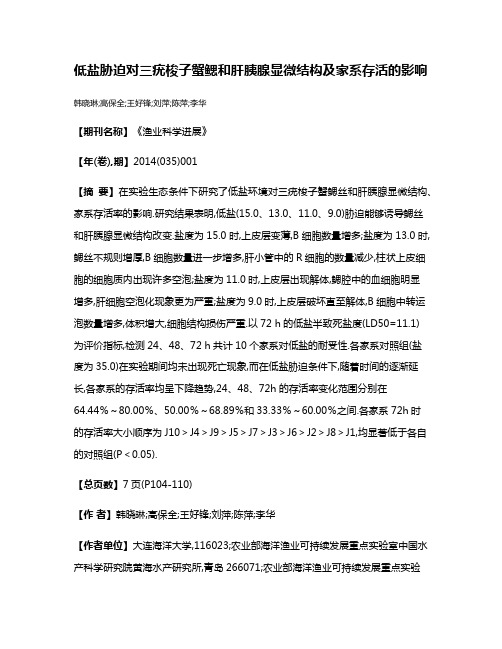
低盐胁迫对三疣梭子蟹鳃和肝胰腺显微结构及家系存活的影响韩晓琳;高保全;王好锋;刘萍;陈萍;李华【期刊名称】《渔业科学进展》【年(卷),期】2014(035)001【摘要】在实验生态条件下研究了低盐环境对三疣梭子蟹鳃丝和肝胰腺显微结构、家系存活率的影响.研究结果表明,低盐(15.0、13.0、11.0、9.0)胁迫能够诱导鳃丝和肝胰腺显微结构改变.盐度为15.0时,上皮层变薄,B细胞数量增多;盐度为13.0时,鳃丝不规则增厚,B细胞数量进一步增多,肝小管中的R细胞的数量减少,柱状上皮细胞的细胞质内出现许多空泡;盐度为11.0时,上皮层出现解体,鳃腔中的血细胞明显增多,肝细胞空泡化现象更为严重;盐度为9.0时,上皮层破坏直至解体,B细胞中转运泡数量增多,体积增大,细胞结构损伤严重.以72 h的低盐半致死盐度(LD50=11.1)为评价指标,检测24、48、72 h共计10个家系对低盐的耐受性.各家系对照组(盐度为35.0)在实验期间均未出现死亡现象,而在低盐胁迫条件下,随着时间的逐渐延长,各家系的存活率均呈下降趋势,24、48、72h的存活率变化范围分别在64.44%~80.00%、50.00%~68.89%和33.33%~60.00%之间.各家系72h时的存活率大小顺序为J10>J4>J9>J5>J7>J3>J6>J2>J8>J1,均显著低于各自的对照组(P<0.05).【总页数】7页(P104-110)【作者】韩晓琳;高保全;王好锋;刘萍;陈萍;李华【作者单位】大连海洋大学,116023;农业部海洋渔业可持续发展重点实验室中国水产科学研究院黄海水产研究所,青岛266071;农业部海洋渔业可持续发展重点实验室中国水产科学研究院黄海水产研究所,青岛266071;农业部海洋渔业可持续发展重点实验室中国水产科学研究院黄海水产研究所,青岛266071;农业部海洋渔业可持续发展重点实验室中国水产科学研究院黄海水产研究所,青岛266071;农业部海洋渔业可持续发展重点实验室中国水产科学研究院黄海水产研究所,青岛266071;大连海洋大学,116023【正文语种】中文【中图分类】S967.9【相关文献】1.低盐胁迫对三疣梭子蟹组织中抗氧化酶和ATP酶活力的影响 [J], 周东;母昌考;宋微微;李荣华;王春琳2.三疣梭子蟹蜕壳周期肝胰腺、外壳和鳃中钙含量的变化 [J], 黄朝辉;母昌考;胡丹丹;宋微微;李荣华;王春琳3.盐度胁迫对三疣梭子蟹(Portunus trituberculatus)鳃中游离氨基酸含量的影响 [J], 付萍;吕建建;刘萍;李健4.盐度胁迫对三疣梭子蟹鳃Na+/K+-ATPase酶活的影响 [J], 江山;许强华5.低盐胁迫下三疣梭子蟹γ-氨基丁酸及其A型受体相关蛋白对渗透压调节的影响[J], 张伟佳;卢少坤;李荣华;王春琳;母昌考;宋微微因版权原因,仅展示原文概要,查看原文内容请购买。
盐度胁迫对三疣梭子蟹存活和摄食的影响
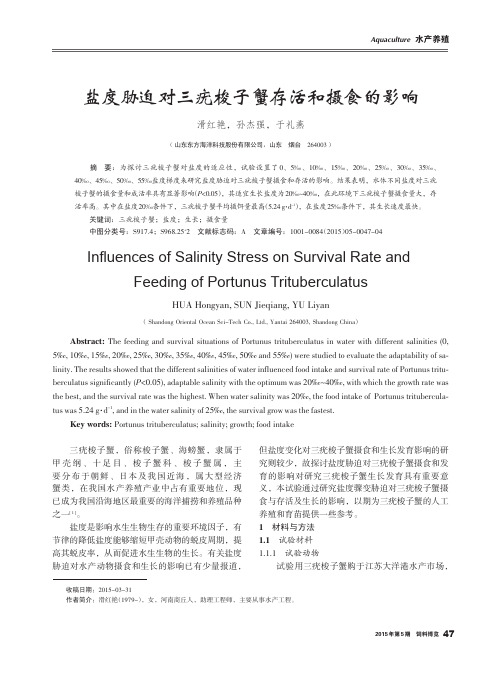
试验所用海水为经沙滤沉淀后的海水,温度为 22~25 ℃,盐度为 26‰~28‰,低盐度海水添加经 24 h 曝气自来水来配制,高盐度海水则通过添加海 水晶来调制,盐度用 ATAGO-8601 型手携式盐度 比重计测定。 1.2 试验方法 1.2.1 试验设计
表 2 不同盐度梯度条件下三疣梭子蟹的活动情况观察
活动情况
刚放入水中时剧烈挣扎、倒退,3 h 后活力明显下降,反应迟钝,失去攻击能力。4h 后出现翻肚现象,呼吸微弱。 6 h 后全部死亡。
刚放入水中时挣扎,爬动,但活力尚好。玻棒触之,举螯示威,四处游走。13 h 后出现死亡,其余活力不佳,摄食不多。 入水时有挣扎现象,适应后反应良好。活力保持不错,有少量摄食。反应稍有迟钝,攻击性不强。 活力一般,活动较少,常静伏于水底,玻棒触之游走别处,有一定量的摄食。 活力相当强,反应灵敏,活动激烈。玻棒靠近,举螯示威,有攻击性。 活力相当强,反应灵敏,活动激烈。玻棒靠近,举螯示威,有很强的攻击性。 活力相当强,反应灵敏,活动激烈。玻棒靠近,举螯示威,有很强的攻击性。 活力相当强,反应灵敏,活动激烈。玻棒靠近,举螯示威,有很强的攻击性。 活力相当强,反应灵敏,活动激烈。玻棒靠近,举螯示威,有攻击性。 活力一般,活动较少,常静伏于水底,玻棒触之游走别处,有一定量的摄食。 初入水挣扎剧烈,6 h 后反应迟缓,攻击性减弱。少量摄食。 入水 3 h 后活力明显下降,反应迟钝,失去攻击能力。5 h 后奄奄一息,接近死亡。
每天 16: 30 投饵 30 g,次日 8: 00 捞取残饵称 重,并换入相应盐度的新鲜海水。试验持续 5 d, 以各盐度梯度的试验个体死亡与否、活力情况、摄 食量作为三疣梭子蟹对各盐度适应的主要指标,观 察到的其他现象作为辅助指标,每次投饵和换水时 记录水温。 1.2.2 盐度胁迫后恢复
盐度对中华绒螯蟹行为、营养成分及基因表达的影响研究进展

119--农业经济•专题综述 DOI:10.16498/ki.hnnykx.2019.003.032中华绒螯蟹,生长在淡水湖泊中,在性腺发育至IV 期后必需向河口或近海处进行生殖洄游,在咸水中蚤状幼体变态发育成为幼蟹时又开始向上进行索饵洄游[1]。
在洄游过程中,外部环境的改变,特别是盐度变化,是影响中华绒螯蟹生理状态最重要的因素之一。
盐度的变化会引起体内和体外渗透压差的出现,中华绒螯蟹通过主动调节自身组织内的盐离子浓度维持渗透压平衡,并调整代谢酶活性[2-3],进而利用渗透压调节器官内的离子转运和稳态,以及调整血淋巴内渗透压和参与盐度代谢的相关基因的表达,来响应外界环境中盐度的改变,从而适应体外生活环境,保证机体正常的生理代谢,维持生命活动的正常进行[4-5]。
因此,这种复杂的生活史使其成为国内外研究渗透压调节生理的模式物种[6]。
关于盐度这一最重要的生态因子对中华绒螯蟹的行为、生理状况以及成熟蟹生殖洄游重新适应盐度升高的调节过程在国内外尚缺乏系统性总结。
这里,在广泛查阅和归纳已有研究的基础上,我们总结了目前国内外研究盐度对中华绒螯蟹行为、营养成分及基因表达影响的现状和进展,并展望了今后的重点研究内容,希望可以补充完善中华绒螯蟹的生理学资料,指导中华绒螯蟹或其他响应盐度改变的水产品种的人工养殖。
1 盐度对中华绒螯蟹行为的影响水体盐度是影响中华绒螯蟹生殖洄游过程中行为的最重要因素之一。
有研究发现,水生动物对环境改变作出的首要反应是行为上的变化[7]。
目前,国内尚没有关于盐度对中华绒螯蟹行为学影响的报道。
国外有研究报道,低盐胁迫下,蟹类的形态、行为和生理等发生一定的调整和改变,如摄食、运动、防御和攻击等[8-10],而关于由低盐到高盐的应激行为的研究则很少,仅仅将其作为一种外界环境因素的改变,研究了其维持渗透压平衡的体内调节机制[11-12],而未见对其行为方面的报道。
因此,探究中华绒螯蟹在不同盐度下的行为学变化,可判断盐度对其行为学的影响,阐释其生殖洄游的机制。
低盐胁迫下三疣梭子蟹γ-氨基丁酸及其A型受体相关蛋白对渗透压调节的影响

低盐胁迫下三疣梭子蟹γ-氨基丁酸及其A型受体相关蛋白对渗透压调节的影响张伟佳;卢少坤;李荣华;王春琳;母昌考;宋微微【摘要】为探究低盐胁迫下γ-氨基丁酸(GABA)及其A型受体相关蛋白(GABARAP)在三疣梭子蟹渗透压调节过程中起到的作用,实验检测了低盐度10条件下,三疣梭子蟹在0,3,6,9,12,24,36,48 h的血清渗透压、血清氯离子(Cl-)浓度等指标,同时对鳃组织的GABA量以及GABARAP基因表达量变化进行测定.结果显示,血清渗透压和血清Cl-浓度在12 h内显著下降(P<0.05),12 h后趋于稳定;相对0 h,血清Cl-浓度降低17.93%,血清渗透压降低24.46%,与外界海水渗透压的差值维持在(183.21±9.51)mOsm?kg-1.GABA量及GABARAP基因表达量波动上升,12 h后基本维持稳定.研究结果表明,三疣梭子蟹对低盐度条件的适应性调节在12 h内进行,之后基本维持稳定,GABA量以及GABARAP基因表达量在此过程中呈现显著的正相关关系,对血清Cl-浓度的调节起到了重要作用,使得12 h后血清渗透压与外界海水渗透压维持在(183.21±9.51)mOsm?kg-1,保证各项生理活动的正常进行.【期刊名称】《宁波大学学报(理工版)》【年(卷),期】2019(032)003【总页数】6页(P9-14)【关键词】三疣梭子蟹;低盐胁迫;γ-氨基丁酸;γ-氨基丁酸A型受体相关蛋白【作者】张伟佳;卢少坤;李荣华;王春琳;母昌考;宋微微【作者单位】宁波大学海洋学院,浙江宁波 315823;浙江海洋高效健康养殖协同创新中心,浙江宁波 315823;宁波大学海洋学院,浙江宁波 315823;宁波大学海洋学院,浙江宁波 315823;浙江海洋高效健康养殖协同创新中心,浙江宁波 315823;宁波大学海洋学院,浙江宁波 315823;浙江海洋高效健康养殖协同创新中心,浙江宁波 315823;宁波大学海洋学院,浙江宁波 315823;浙江海洋高效健康养殖协同创新中心,浙江宁波 315823;宁波大学海洋学院,浙江宁波 315823;浙江海洋高效健康养殖协同创新中心,浙江宁波 315823【正文语种】中文【中图分类】Q592.1;S968.25三疣梭子蟹(Portunus trituberculatus)是我国重要的海洋经济蟹类,具有较高的经济价值,也是我国沿海地区的重要养殖种类,在黄渤海的产量最大[1].三疣梭子蟹具有生长快、适宜食用、养殖利润高等特点[2].在三疣梭子蟹养殖过程中,恶劣的天气状况如暴雨或是大量换水等都会造成养殖水体盐度的突变,造成大量发病甚至死亡.盐度是影响甲壳动物生理代谢的重要环境因子[3],如渗透调节、免疫防御、呼吸代谢等生理功能都直接影响着甲壳动物的生长发育.水生甲壳动物随着生存环境盐度的改变,在神经分泌系统调控下,渗透调节器官的结构、血清渗透压和离子转运等都会发生一系列变化,以适应外界环境中盐度的改变,维持机体正常的生理代谢活动.水生甲壳动物渗透压调节的主要器官是鳃,三疣梭子蟹的鳃分为前鳃和后鳃,前鳃的主要作用为呼吸,后鳃的主要作用为离子转运、渗透压调节(前鳃及后鳃各3对).氯离子(Cl-)作为海水及三疣梭子蟹血清中的主要阴离子,在三疣梭子蟹的渗透压调节中具有重要作用.关于水生甲壳动物鳃的功能研究已经被证明,Cl-转运和渗透压调节的场所主要定位于后鳃[4].γ-氨基丁酸(γ-aminobutyric Acid,GABA)是一种非蛋白氨基酸,是中枢神经系统中重要的抑制性神经递质,它通过与其他受体结合从而调节机体的生理功能[5].有研究表明GABA与生物对盐度胁迫的抗性相关[6].GABA可以协助GABA受体打开氯离子通道,对氯离子进行主动运输,对生物渗透压的调节具有重要作用[7].GABA受体分为3种亚型:GABAA、GABAB、GABAC,不同亚型的生理特性及分布有所差异.GABAA是三者中最为重要的一种,由GABA受体识别点、苯二氮卓(BDZ)识别点和Cl-门控通道3部分组成的大分子蛋白复合体,属配体门控离子通道(LGICS)超家族,研究表明GABAA在个体生长发育、离子转运、渗透压调节、食物吸收等方面具有重要调节作用[8].GABAA受体功能受到 GABAA受体相关蛋白(GABAAReceptor Associated Protein,GABARAP)调节,GABARAP能将GABAA受体转移到质膜上,从而提高GABAA受体活性和氯离子转运效率[9-10].目前国内外关于盐度胁迫下三疣梭子蟹免疫、存活和生长方面已经有较多研究报道,但关于盐度胁迫下 GABA及其受体对三疣梭子蟹渗透压调节作用的研究甚少.本文检测了低盐10胁迫下0,3,6,9,12,24,36,48h 共 8 个时间点的血清渗透压、血清 Cl-浓度,同时测定了对应时间点三疣梭子蟹鳃组织的GABA量和GABARAP基因表达量的变化,以探究GABA及其A型受体相关蛋白对三疣梭子蟹血清渗透压调节的影响.1 材料与方法1.1 实验材料实验所用三疣梭子蟹体重为(12.5±1.8)g,来自浙江的宏野水产有限公司.实验前,于自然海水盐度下(盐度为30)暂养7d.暂养期间连续充气,每天定时投喂新鲜小鱼,换水清污.1.2 实验方法1.2.1 盐度条件设置实验设置海水盐度为10,每个组均设3个平行.盐度为10的低盐海水用自然海水(盐度为30)加入曝气自来水调配,用YSI盐度仪校准.实验于水桶中进行,温度18~20℃.每组90只蟹,实验期间饲养管理与暂养期间相同.1.2.2 样品采集与保存取 0,3,6,9,12,24,36,48h 三疣梭子蟹样品.从每组中随机抽取5只三疣梭子蟹,抽取心脏处血淋巴1mL于1.5mL离心管内,加等量抗凝剂.将血淋巴样品混匀,在4℃下 3000r⋅min-1离心 15 min,用移液器吸取上清液于新的1.5mL离心管中,标记编号后,置于-80℃冰箱中保存,用于测定血清渗透压和血清Cl-浓度;解剖取后2对鳃,分成2份,1份放进 50mL离心管,加入 RNA 保护液(CoWin Biotech,中国);另 1 份放进 1.5mL 离心管用于 GABA 量测定.所有样品用液氮冷冻,放入-80℃冰箱保存.每个采样时间点取自然盐度海水和低盐胁迫实验用海水各1mL,于1.5mL离心管中,各取3个样本,标记编号后置于液氮保存.1.2.3 渗透压和Cl-含量测定采用Fiske Micro-Osmometer 210冰点渗透压计(ADVANCED,美国)测定血清及环境海水渗透压.氯离子检测试剂盒(南京建成,中国)测定血清中的Cl-,操作按试剂盒说明书进行.1.2.4 GABA量测定采用毛细管电泳检测蟹鳃中 GABA量.首先用IKA T10(IKA,德国)对鳃进行称重和匀浆,然后进行FMOC-CL衍生,缓冲液经0.45μm孔的膜过滤器过滤后,经超声脱气 1min.电泳缓冲液由60 mmol⋅L-1硼酸盐,60mmol⋅L-1SDS,20mmol⋅L-1β-CD,3%(v/v)异丙醇组成,NaOH 调节 pH 至 9.5.所有分离操作均在装有UV检测器的Beckman毛细电泳仪上进行.毛细管使用65cm×75μm的未涂层熔融石英毛细管(永年光纤,中国).1.2.5 GABARAP基因表达量测定TRIzol® Reagent(Invitrogen,美国)分离每个样品的总RNA.SuperRT Reverse Transcriptase (Co Win Biotech,中国)合成 cDNA 模板,-20 ℃保存用于实时定量 PCR.根据产品说明书,应用 Ultra-SYBR预混体系经Master cyclerep Realplex PCR仪(Eppendorf,德国)实时定量技术分析相关基因表达情况.实验选择RPL-18作为管家基因,GABARAP序列来源自实验室三疣梭子蟹转录组数据库,采用Primer 5.0设计引物(表1).表1 实验中用到的引物序列项目Primer sequence(5’-3’)RPL-18 GCACTGTCACCGATGACCTC CCTTGCACCAGCAGAGTGTT GABARAP CGGCTACTATGGGGTCCCTCTA CCAATCCGTCACCTACCCACTqPCR程序设置为95℃ 10min,随后40个循环,94℃ 15s,60 ℃ 30s,72 ℃ 30s.在每个 PCR反应结束时,进行扩增产物的解离分析,用比较阈值法分析靶基因的表达水平.1.2.6 统计分析实验数据用平均值±标准方差表示(mean±SD).采用 SPSS 19.0进行单因素方差分析(One-Way ANOVA)和 Duncan检验,对不同测定指标进行差异比较,数据统计的显著性水平设定为P<0.05.2 实验结果2.1 血清渗透压和血清Cl-浓度测定低盐胁迫下,8个时间点三疣梭子蟹血清Cl-浓度、血清渗透压测定结果见表2.实验期间,外界海水渗透压保持在(367.00±9.51)mO sm⋅kg-1.在 0~12h内,三疣梭子蟹血清渗透压和血清 Cl-浓度显著下降(P<0.05),12h 后,血清 Cl-浓度降至165.62 mmol⋅L-1左右,相对 0h,下降 17.93%;12h 血清渗透压下降至559.50mOsm⋅kg-1左右,相对0h,下降24.46%.12h后,血清Cl-浓度和血清渗透压趋于稳定,血清渗透压与外界海水渗透压差值维持在(183.21±9.51)mOsm⋅kg-1.表2 血清Cl-浓度和血清渗透压注:表中数据为平均值±标准差,n=3,同列数据上标完全不同小写字母表示差异显著(P<0.05),下表同.时间/h 血清Cl-浓度/(mmol⋅L-1)血清渗透压/(mOsm⋅kg-1)0 201.81±11.74a740.67±2.08a3 201.58±10.90a660.67±2.52b6 191.18±5.52ab630.33±12.22c9177.72±9.51bc602.67±16.50d12 165.62±14.39c559.50±10.61e24168.00±4.19c557.00±10.82e36 175.50±6.63bc544.33±5.13e48171.23±6.72c540.00±10.50e2.2 GABA量和GABARAP基因表达量低盐胁迫下,8个时间点三疣梭子蟹鳃中的GABA量和GABARAP基因表达量检测结果见表3.可以看出,GABA量在0~3h没有发生变化,3h后开始显著升高(P <0.05),在12~24h有所下降,但差异不显著;而GABARAP基因表达量从0h 开始显著升高,同样在 12~24h稍有下降,但差异不显著.GABA量和GABARAP 基因表达量在12h达到峰值,之后总体趋于稳定.2.3 低盐胁迫下三疣梭子蟹生理指标的变化及其相关性分析三疣梭子蟹GABA量、GABARAP基因表达量、血清 Cl-浓度和血清渗透压在各检测时间点的变化如图 1所示(图中同折线上标不同小写字母表示差异显著,P<0.05).在低盐度10胁迫条件下,血清 Cl-浓度和血清渗透压均呈现降低趋势,在12h达到相对稳定,相关性分析结果显示:血清 Cl-浓度和血清渗透压的相关系数为 0.909,呈显著正相关(P<0.05).而GABA量和GABARAP基因表达量均呈现波动上升趋势,并在12h达到相对稳定.相关性分析显示,GABA量和GABARAP基因表达量的相关系数为0.916,呈显著正相关(P<0.05).表3 GABA量和GABARAP基因表达量时间/h GABA 量/(μg⋅g-1) GABARAP基因表达量0 9.65±2.98a1.03±0.29a3 9.68±1.97a2.74±0.68bc615.97±2.63ab2.84±0.34bc9 15.01±4.51ab2.49±0.18b1228.67±6.34c4.91±0.68cd24 22.64±4.72bc3.26±0.51bc3626.43±4.95c4.91±0.68d4825.92±3.21c4.48±0.61d图1 低盐胁迫下三疣梭子蟹血清Cl-浓度、血清渗透压、GABA量及GABARAP 基因表达量的变化3 讨论3.1 低盐胁迫下三疣梭子蟹血清Cl-浓度和血清渗透压的变化甲壳动物对盐度的适应能力主要体现在对渗透压和离子浓度的调节能力上,渗透压调节主要通过调节血液中无机离子和自由氨基酸含量实现,而其中又主要通过调节无机离子含量实现[11-12].已有很多学者对脊尾白虾[13]、凡纳滨对虾[14]等甲壳类动物进行了盐度胁迫实验,通过盐度胁迫下部分生化指标发生的变化来探究盐度胁迫对甲壳类动物的影响.研究表明,渗透压调节主要由鳃Na+/K+-ATPase起作用[15],细胞外液的渗透压主要来源于 Na+和 Cl-,细胞内液的渗透压主要来源于K+和 Cl-,所以 Na+/K+的调节总是伴随着 Cl-转运.Na+、Cl-是形成渗透压的 2种主要离子,所占比例高达 76%~90%[16].因此,血清 Cl-浓度的变化与血清渗透压的变化密切相关.本实验中,由于受到低盐度 10胁迫,三疣梭子蟹体内 Cl-浓度高于外部介质,Cl-顺着浓度差大量外流,使得体内血清渗透压降低.三疣梭子蟹的血清 Cl-浓度和血清渗透压在 0~12h持续下降,呈显著正相关,但在12h后基本趋于稳定.由此可以判断,三疣梭子蟹在盐度为 10的海水中,渗透压调节时间为12h左右.文献[17-18]的研究表明,三疣梭子蟹在盐度 5~50等不同盐度胁迫下,渗透压在12~24h之间达到稳定,说明三疣梭子蟹渗透压的调节时间会随着盐度梯度的改变而变化,但基本在12~24h完成.甲壳动物对外界渗透压的适应性调节具有不同的类型.卢俊等[19]研究发现,中华绒螯蟹在低盐胁迫时,血清中离子浓度和渗透压都显著高于养殖水体,且水体盐度越高,血清渗透压与环境渗透压差异越小,其渗透压调节类型属于高渗调节型.而Chen等[16]发现青蟹在盐度胁迫下,血清渗透压始终低于环境渗透压,是一种低渗调节型蟹类.本实验中,三疣梭子蟹血清渗透压始终高于低盐度(盐度为 10)海水的渗透压,未出现等渗现象,属于渗透压调节型中的高渗调节型[17].3.2 GABARAP对Cl-转运的影响细胞质膜对某一特定离子的高度透性依赖于特异性通道的存在,细胞质膜上存有大量与离子转运有关的结构,如离子通道和相关酶等[20].研究证明,GABAA受体是由镶嵌于细胞质膜双脂层中的5个亚基(来自8个亚基族)组成的五边形异质性多肽类寡聚体,其中心部位形成一个直径为0.5nm的GABA门控Cl-通道,选择性地通过带负电荷的Cl-[21].GABAA受体的配体通过改变复杂的GABAA受体构象,来调节 Cl-通道中的 Cl-流量,增强或减弱GABA作用于受体的效能.GABA激活质膜上的GABAA受体,使 Cl-门控通道开启,导致 Cl-内流[22].受到盐度为 10的低盐海水胁迫,三疣梭子蟹体内 Cl-顺着浓度差外流,从而使得体内渗透压降低,但随着 GABARAP表达量的增加,提高了GABAA受体的活性和氯离子的转运效率[9],使得海水中Cl-也通过GABAA受体上的Cl-门控通道内流,血清 Cl-浓度以及体内渗透压没有持续降低,该调节过程在12h左右达到稳定状态,此时,三疣梭子蟹体内血清Cl-浓度下降17.93%,血清渗透压下降24.46%.3.3 GABA对血清渗透压调节的影响当外界盐度发生变化时,甲壳类动物先通过离子浓度(主要为 Na+、Cl-)调节渗透压,在极端条件下,会通过自由氨基酸调节渗透压.三疣梭子蟹血淋巴和肌肉中含量较高的自由氨基酸主要为牛磺酸(Tau)、精氨酸(Arg)、甘氨酸(Gly)、脯氨酸(Pro)和丙氨酸(Ala).发挥主要渗透压调节作用的自由氨基酸为脯氨酸(Pro)、丙氨酸(Ala)、甘氨酸(Gly)、天冬氨酸(Asp)、谷氨酸(Glu),研究表明这些自由氨基酸对渗透压的调节具有较为重要作用[23].GABA 是非蛋白氨基酸,属于自由氨基酸的一种,可以促进细胞膜上 GABAA受体生成,通过对 Cl-转运的调节从而间接调控渗透压变化[24].本实验结果表明,GABA量在 12h内显著升高(相对0h增加了197.10%),GABA量的升高可能在一定程度上促进了 GABAA受体数量的增加,同时也协助 GABAA受体打开氯离子通道对 Cl-进行主动运输[7],提高了转运效率.从本实验结果可以看出,三疣梭子蟹血清 Cl-浓度和血清渗透压的变化伴随着GABA量和GABARAP基因表达量的变化,在0~12h血清Cl-浓度和血清渗透压逐渐降低的过程中,GABA量以及GABARAP基因表达量逐渐上升,12h后GABA量与 GABARAP基因表达量趋于稳定,同时血清Cl-浓度及血清渗透压也趋于稳定,体现了较强的协同作用.4 结论研究结果表明,三疣梭子蟹在盐度为 10的低盐海水胁迫下,调节血清渗透压以适应低盐环境时间为 12h,且体内始终处于高渗状态,血清渗透压与外界海水渗透压差值维持在(183.21±9.51)mOsm⋅kg-1.三疣梭子蟹在降低血清渗透压以适应低盐环境的过程中,Cl-顺着浓度差外流,而鳃中GABA 量及 GABARAP表达量的增加,提高了GABAA受体活性和氯离子的转运效率,促进Cl-通过 Cl-门控通道内流,及时维持血清 Cl-浓度,从而稳定血清渗透压.说明鳃中 GABA及 GABARAP与三疣梭子蟹血清渗透压调节密切相关.本实验揭示了低盐10胁迫下三疣梭子蟹体内Cl-浓度和血清渗透压的变化规律,以及 GABA及 GABARAP在血清渗透压调节过程中的重要作用,为进一步探究 GABA及其相关通路在三疣梭子蟹渗透压调节中的作用奠定了基础.参考文献:【相关文献】[1]周双林,姜乃澄,卢建平,等.甲壳动物渗透压调节的研究进展I.鳃的结构与功能及其影响因子[J].海洋学研究,2001,19(1):45-52.[2]王冲,姜令绪,王仁杰,等.盐度骤变和渐变对三疣梭子蟹幼蟹发育和摄食的影响[J].水产科学,2010,29(9):510-514.[3]孙颖民,宋志乐,严瑞深,等.三疣梭子蟹生长的初步研究[J].生态学报,1984,4(1):59-66.[4]江山,许强华.盐度胁迫对三疣梭子蟹鳃 Na+/K+-ATPase 酶活的影响[J].水产学报,2011,35(10):1475-1480.[5]堀江典子,菅美奈子,金武祚.GABA(γ-氨基丁酸)的功能性[J].中国食品添加剂,2010(6):169-173.[6]AL-Quraan N A,Sartawe F A,Qaryouti M M.Characterization of γ-aminobutyric acid metabolism and oxidative damage in wheat (Triticum aestivum L.)seedlings under salt and osmotic stress[J].Journal of Plant Physiology,2013,170(11):1003-1009.[7]Ducić I,Caruncho H J,Zhu W J,et al.gamma-Aminobutyric acid gating of Cl-channels in recombinant GABAAreceptors[J].Journal of Pharmacology &Experimental Therapeutics,1995,272(1):438- 445.[8]袁莲芳,陈果,贾宏阁,等.GABAA受体研究现状[J].现代临床医学,2014,40(2):89-92.[9]Leil T A,Chen Z W,Chang C S,et al.GABAAreceptorassociated protein traffics GABAAreceptors to the plasma membrane in neurons[J].The Journal of Neuroscience:The Official Journal of the Society for Neuroscience,2004,24(50):11429-11438. [10]Chen Z W,Olsen R W.GABAAreceptor associated proteins:A key factor regulating GABAAreceptor function[J].Journal of Neurochemistry,2007,100:279-294.[11]Lima A G,Mcnamara J C,Terra W R.Regulation of hemolymph osmolytes and gill Na+/K+-ATPase activities during acclimation to saline media in the freshwater shrimp Macrobrachium olfersii (Wiegmann,1836)(Decapoda,Palaemonidae)[J].Journal of Experimental Marine Biology & Ecology,1997,215(1):81-91.[12]Via J D.The effect of salinity on free amino acids in the prawn Palaemonelegans(Rathke)[J].Archiv Fur Hydrobiologie,1989,115(1):125-135.[13]Ren H,Li J,Li J,et al.Cloning of catalase and expression patterns of catalase and selenium-dependent glutathione peroxidase from Exopalaemon carinicauda in responseto low salinity stress[J].Acta Oceanologica Sinica,2015,34(8):52-61.[14]孙武卫.低盐胁迫下凡纳滨对虾消减 cDNA文库构建及谷氨酰胺合成酶 cDNA克隆和表达[D].湛江:广东海洋大学,2012.[15]Morris S.Neuroendocrine regulation of osmoregulation and the evolution of air-breathing in decapod crustaceans[J].Journal of Experimental Biology,2001,204(5):979-989.[16]Chen J C,Chia P G.Osmotic and ionic concentrations ofScylla serratasubjected to different salinity levels[J].Comparative Biochemistry & Physiology Part A Physiology,1997,117(2):239-244.[17]马金武,吕建建,刘萍,等.急性盐度胁迫对三疣梭子蟹(Portunus trituberculatus)“黄选1号”血清渗透压及离子含量的影响[J].渔业科学进展,2016,37(1):58-62.[18]王林,潘鲁青.三疣梭子蟹在低盐胁迫下渗透生理适应性的研究[J].海洋湖沼通报,2016(3):106-112.[19]卢俊,庄平,冯广朋,等.中华绒螯蟹亲蟹渗透压调节和抗氧化系统对盐度的响应[J].海洋渔业,2011,33(1):39-45.[20]马金武,吕建建,刘萍,等.盐度胁迫对三疣梭子蟹“黄选1号”血清部分生化指标的影响[J].水产学报,2017,41(4):506-511.[21]王秀坤,Nielsen M.GABAA受体药理学研究进展[J].国际药学研究杂志,2001,28(1):29-34.[22]梁臣,陈忠.γ-氨基丁酸及其受体功能的研究与应用现状[J].动物医学进展,2015,36(4):108-112.[23]付萍,吕建建,刘萍,等.盐度胁迫对三疣梭子蟹肌肉和血淋巴中游离氨基酸含量的影响[J].水产学报,2017,41(3):374-381.[24]Eshaq R S,Stahl L D,Smith S S,et al.GABA acts as a ligand chaperone in the early secretory pathway to promote cell surface expression of GABAAreceptors[J].Brain Research,2010,1346(8):1-13.。
短期饥饿胁迫对三疣梭子蟹幼蟹生化组成的影响

1 1 材 料 .
三 疣梭 子 蟹 ( o uu i b cl u) P r ns rue u ts 俗称 梭 子蟹 , 属 于 t tt r a 隶 甲壳 纲 、 足 目、 十 游泳 亚 目、 梭子 蟹 科 、 子蟹 属 , 布 于 中 国 、 梭 分 日本 及 朝 鲜 等 海域 , 我 国 的分 布 最 广 , 起 辽 东 半 岛 , 至 在 北 南
作者简介 : 於叶兵( 90 ) 男, 18 一 , 江苏南通人 , 硕士, 讲师 , 研究方 向为
水产经济动物增养殖 。T l( 55 8 28 9 :E l :ueig0 5 e:0 1 ) 89 6 5 ma yyb 20 l n
@ 1 6 em 。 2 .o
每 一样 品重 复 测 定 3次 。数 据 统 计 分 析 采 用 S S 1 . PS2o
一
3 0一 4
江苏农业科学
21 0 0年第 5期
於叶兵 , 黄金田, 王 峰, 等.短期饥饿胁迫对三疣梭子蟹幼蟹生化组成 的影响[] J .江苏农业科学 ,00 5 :4 2 1 ( )3 0—32 4
短期 饥饿 胁迫对 三疣 梭子 蟹 幼蟹 生化组 成 的影 响
於叶 兵 黄金 田 王 , , 峰。 唐 玉江 孙 玲玲 , ,
初期粗蛋 白、 粗脂肪和糖类 的相对损失率最大的为粗脂肪 , 粗蛋 白和糖类 次之 , 且粗脂肪降 幅高峰 的出现 时段早于粗
蛋白和糖类 , 饥饿期间三疣 梭子蟹幼蟹首先主要利用粗脂肪提供能量 , 然后才是粗蛋 白和糖类。试验 期间粗蛋 白、 粗 脂肪 、 类 的 质量 分 数 和 能值 的变 化 与饥 饿 时 间 呈显 著 负 相 关 关 系 ( 0 【 ) 粗 蛋 白 、 脂 肪 和糖 类 的 质 量 分 数 变 糖 P< . 1 ; 】 粗
盐胁迫对梭梭、盐爪爪种子萌发和幼苗生长的影响
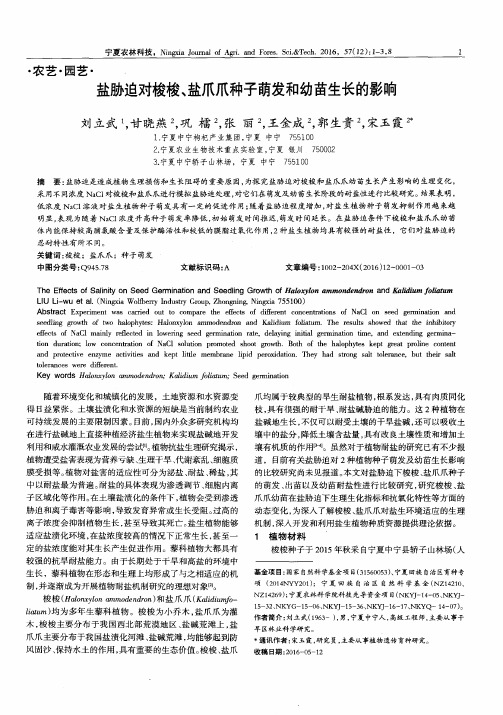
1 . 宁夏 中宁枸杞产 业集 团, 宁夏 中宁 7 5 5 1 O 0 2 . 宁夏农业生物技术重 点实验 室, 宁夏 银川 7 5 0 0 0 2 3 . 宁夏 中宁轿子 山林场 ,宁夏 中宁
T h e E f e c t s o f S a l i n i t y o n S e e d Ge r mi n a t i o n a n d S e e d l i n g Gr o wt h o f Ha l o x y l o n a mmo n d e n d r o n a n d K a l i d i u m f o l i a t u m
摘
7 5 5 1 O 0
要: 盐 胁 迫是 造 成植 物 生理 损 伤 和 生 长 阻碍 的 重要 原 因 , 为 探 究盐 胁 迫 对 梭 梭 和 盐 爪 爪 幼 苗 生 长 产 生 影 响 的 生理 变化 ,
采用不同浓度 Na c l 对梭梭和盐爪爪进行模拟盐胁迫处理 , 对它们在 萌发及幼苗生长阶段 的耐盐性进行 比较研 究。 结果表 明, 有一定的促进作 用 ; 随着盐胁 迫程 度增加 , 对 盐生植物种子 萌发 抑制作 用越 来越
明显 , 表 现为随着 Na C 1 浓度 升 高种子 萌发 率降低 , 初始 萌发 时 间推迟, 萌发时 间延 长。在盐胁 迫条件 下梭梭 和盐爪爪幼苗
体 内能保持较 高脯氨酸含量及保护酶活性和较低 的膜脂过氧化作 用, 2 种 盐生植 物均具有较 强的耐盐性 ,它们 对盐胁迫的
忍 耐 特 性 有 所 不 同。 关键 词 : 梭 梭 ; 盐爪 爪 ;种 子 萌发 中图分类号 : Q9 4 5 . 7 8 文献标识码 : A 文章编号 : 1 0 0 2 — 2 0 4 X( 2 0 1 6 ) 1 2 - 0 0 0 1 — 0 3
三疣梭子蟹几丁质酶基因克隆鉴定及在低盐胁迫和蜕皮周期中的表达分析

三疣梭子蟹几丁质酶基因克隆鉴定及在低盐胁迫和蜕皮周期中的表达分析张凤;吕建建;刘萍;高保全;李健;陈萍【期刊名称】《海洋与湖沼》【年(卷),期】2015(046)004【摘要】几丁质酶在甲壳动物中参与多个生物学进程,发挥重要作用.本研究采用RACE技术,克隆获得总长为3694 bp的三疣梭子蟹(Portunustrituberculatus)几丁质酶基因全长cDNA序列,命名为PtCht基因.该基因5 '和3'非编码区分别为200bp和455bp,开放阅读框为3039bp,推测编码1012个氨基酸,预测分子量为113.4kDa,理论等电点为6.289.生物信息学分析表明,PtCht基因含有2个催化结构域和1个几丁质结合结构域ChtBD2,催化结构域具有几丁质酶第18家族的保守基序Motif Ⅰ、Ⅱ、Ⅲ、Ⅳ;同源性和系统进化分析表明,三疣梭子蟹PtCht基因与亚洲玉米螟(Ostrinia furnacalis)Cht的同源性最高;荧光定量RT-PCR分析表明,PtCht基因在各组织中均有表达,而在眼柄和表皮中的相对表达量较高.PtCht基因在蜕皮周期中的表达规律表明,PtCht基因在不同蜕皮时期存在明显变化,在表皮中先下调后上调;在眼柄中,呈整体上调趋势.通过分析PtCht基因在低盐胁迫进程中的表达规律发现,低盐胁迫可显著改变PtCht基因在鳃和肝胰腺中的表达模式,整体呈先下降后上升最后下降的表达趋势.该研究结果表明PtCht基因在三疣梭子蟹蜕皮发育和渗透压调节中发挥重要作用,为深入研究三疣梭子蟹和其它甲壳动物几丁质酶的功能提供了重要信息.【总页数】10页(P948-957)【作者】张凤;吕建建;刘萍;高保全;李健;陈萍【作者单位】中国水产科学研究院黄海水产研究所青岛 266071;上海海洋大学水产与生命学院上海201306;中国水产科学研究院黄海水产研究所青岛 266071;中国水产科学研究院黄海水产研究所青岛 266071;中国水产科学研究院黄海水产研究所青岛 266071;中国水产科学研究院黄海水产研究所青岛 266071;中国水产科学研究院黄海水产研究所青岛 266071【正文语种】中文【中图分类】S9【相关文献】1.三疣梭子蟹(Portunus trituberculatus)RXR基因克隆及其在蜕皮过程中的表达分析 [J], 王伟;吴旭干;楼宝;徐蕾;刘智俊;成永旭2.三疣梭子蟹Na+/H+-exchanger基因克隆鉴定及在盐度胁迫下的表达分析 [J], 马金武;吕建建;刘萍;高保全;李健3.三疣梭子蟹(Portunus trituberculatus)几丁质酶PtCht3基因克隆鉴定及表达分析 [J], 张凤;吕建建;刘萍;高保全;李健4.三疣梭子蟹几丁质酶基因的克隆及其在蜕皮过程中的表达分析 [J], 王伟;吴旭干;潘桂平;侯文杰;成永旭5.三疣梭子蟹FAMeT基因克隆及其在蜕皮周期中的表达水平 [J], 谢熙;朱冬发;崔晓雨;汤洁;邱锡尔因版权原因,仅展示原文概要,查看原文内容请购买。
三疣梭子蟹“黄选1号”盐度耐受性及适宜生长盐度分析

三疣梭子蟹“黄选1号”盐度耐受性及适宜生长盐度分析隋延鸣;高保全;刘萍;任宪云;李洋;丁金强;段亚飞【期刊名称】《大连海洋大学学报》【年(卷),期】2012(027)005【摘要】对三疣梭子蟹Portunus trituberculatus"黄选1号"群体进行盐度胁迫试验,结果表明:24、48、72 h低盐海水对三疣梭子蟹的半致死浓度分别为5.13、7.49和8.56;24、48、72 h高盐海水的半致死浓度分别为54.49、52.74和52.21;三疣梭子蟹"黄选1号"安全存活盐度为13.7~47.7。
在三疣梭子蟹安全存活盐度范围内设置6个盐度梯度,分别为18.7、23.7、28.7、33.7(自然海水对照组)、38.7和43.7,在不同盐度梯度下对80日龄三疣梭子蟹"黄选1号"进行40 d的养殖试验,结果表明:各盐度组三疣梭子蟹的存活率分别为60%、59%、63%、49%、48%和38%;低盐组(18.7、23.7、28.7)的存活率、增重率和蜕皮速度均比高盐组(33.7、38.7和43.7)好且差异显著(P〈0.05)。
综合比较表明,三疣梭子蟹"黄选1号"生长的最适宜盐度为28.7。
【总页数】4页(P398-401)【作者】隋延鸣;高保全;刘萍;任宪云;李洋;丁金强;段亚飞【作者单位】【正文语种】中文【中图分类】S917【相关文献】1.三疣梭子蟹“黄选1号”盐度耐受性及适宜生长盐度分析 [J], 隋延鸣;高保全;刘萍;任宪云;李洋;丁金强;段亚飞2.三疣梭子蟹蚤状幼体的生存下限盐度及适宜盐度的研究 [J], 张德波;李爱国3.急性盐度胁迫对三疣梭子蟹(Po rtunus trituberculatus)“黄选1号”血清渗透压及离子含量的影响 [J], 马金武;吕建建;刘萍;高保全;李健4.三疣梭子蟹“黄选1号”盐度耐受性分析 [J], 隋延鸣;高保全;刘萍;任宪云;李洋;丁金强;段亚飞5.盐度胁迫对三疣梭子蟹“黄选1号”血清部分生化指标的影响 [J], 马金武;吕建建;刘萍;高保全;李健因版权原因,仅展示原文概要,查看原文内容请购买。
盐度胁迫下三疣梭子蟹热休克蛋白HSP90a的原核表达

盐度胁迫下三疣梭子蟹热休克蛋白HSP90a的原核表达覃烨;许强华【期刊名称】《水产学报》【年(卷),期】2012(036)005【摘要】Heat shock protein 90 is a multi-functional molecular chaperone that plays an essential role in both cellular metabolism and stress response. The swimming crab, Portunus trituberculatus is an important marine fishery and aquaculture species. Water salinity conditions influence its artificial propagations significantly. In order to prove the relationships between HSP90a protein and salinity stress, we investigated the prokaryotic expression of P. trituberculatus HSP90a recombinant protein under a series of salinity stress. Based on the coding sequences of P. trituberculatus HSP90a protein in GenBank, we cloned the full length of HSP90a gene. Recombinant pET28-HSP90a prokaryotic expression recombinant plasmid was constructed and expressed in Escherichia coll DE3 (BL21) under a series of salinity stress. Results showed that the survival rate of recombinant plasmid transferred Escherichia coli was higher than that of empty vector transferred cells. When the salinity challenge was close to the salinity tolerance maximum value of E. coli, the difference of survival rate between those two kinds of cells became more significant. For example, at the highest salinity challenge condition (1 050 mmol/L), the survival rate of recombinant plasmid transferred E. coli was 10.7 timeshigher than that of empty vector transferred cells. Therefore, our results indicated that P. trituberculatus HSP90a protein possessed protective effect against salinity stress and HSP90a protein might be involved in salinity adaptation physiological process in P. trituberculatus.%为证明三疣梭子蟹HSP90a蛋白与盐度胁迫的相关性,实验根据GenBank上提供的三疣梭子蟹HSP90a基因蛋白编码区序列,构建pET28-HSP90a原核表达重组质粒在大肠杆菌DE3(BL21)中进行的盐度胁迫表达.结果显示,转重组质粒的大肠杆菌生存率明显高于转空载体的大肠杆菌,越接近大肠杆菌盐度耐受极限值,两者差异越显著,在盐度胁迫最高值(1 050mmol/L)下,两者差异达到10.7倍,说明在盐度胁迫下三疣梭子蟹HSP90a对大肠杆菌有保护作用,能显著提高大肠杆菌对盐度胁迫的耐受力.由此推测,HSP90a蛋白可能参与了三疣梭子蟹盐度适应的生理过程.【总页数】5页(P681-685)【作者】覃烨;许强华【作者单位】上海海洋大学海洋科学学院,上海201306;上海海洋大学海洋科学学院,上海201306;上海海洋大学大洋渔业资源可持续开发省部共建教育部重点实验室,上海201306;上海海洋大学农业部大洋渔业资源环境科学观测实验站,上海201306;上海海洋大学国家远洋渔业工程技术研究中心,上海201306【正文语种】中文【中图分类】Q786;S917.4【相关文献】1.三疣梭子蟹Na+/H+-exchanger基因克隆鉴定及在盐度胁迫下的表达分析 [J], 马金武;吕建建;刘萍;高保全;李健2.盐度胁迫对三疣梭子蟹肌肉和血淋巴中游离氨基酸含量的影响 [J], 付萍;吕建建;刘萍;李健;高保全3.盐度胁迫对三疣梭子蟹“黄选1号”血清部分生化指标的影响 [J], 马金武;吕建建;刘萍;高保全;李健4.三疣梭子蟹水通道蛋白1 cDNA及其盐度胁迫下的表达分析 [J], 王渝;吕建建;刘萍;高保全;李健;陈萍5.盐度胁迫下三疣梭子蟹Ferritin基因的原核表达 [J],因版权原因,仅展示原文概要,查看原文内容请购买。
盐度变化对杜氏盐藻的游离氨基酸和脂肪酸含量的影响
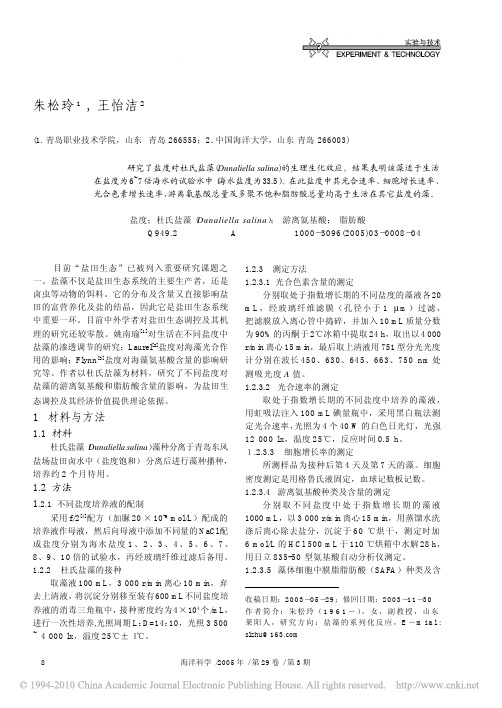
盐度变化对杜氏盐藻的游离氨基酸和脂肪酸含量的影响朱松玲1, 王怡洁2(1. 青岛职业技术学院,山东 青岛 266555;2.中国海洋大学,山东青岛 266003)摘要 :研究了盐度对杜氏盐藻(Dunaliella salina)的生理生化效应。
结果表明该藻适于生活在盐度为6~7倍海水的试验水中(海水盐度为33.5)。
在此盐度中其光合速率、细胞增长速率、光合色素增长速率,游离氨基酸总量及多聚不饱和脂肪酸总量均高于生活在其它盐度的藻。
关键词:盐度;杜氏盐藻(Dunaliella salina);游离氨基酸;脂肪酸中图分类号:Q949.2 文献标识:A 文章编号:1000-3096(2005)03-0008-04目前“盐田生态”已被列入重要研究课题之一。
盐藻不仅是盐田生态系统的主要生产者,还是卤虫等动物的饵料。
它的分布及含量又直接影响盐田的富营养化及盐的结晶,因此它是盐田生态系统中重要一环。
目前中外学者对盐田生态调控及其机理的研究还较零散。
姚南瑜[1]对生活在不同盐度中盐藻的渗透调节的研究;Laurel[2]盐度对海藻光合作用的影响;Flynn[3]盐度对海藻氨基酸含量的影响研究等。
作者以杜氏盐藻为材料,研究了不同盐度对盐藻的游离氨基酸和脂肪酸含量的影响,为盐田生态调控及其经济价值提供理论依据。
1 材料与方法1.1 材料杜氏盐藻(Dunaliella salina)藻种分离于青岛东风盐场盐田卤水中(盐度饱和)分离后进行藻种播种,培养约2个月待用。
1.2 方法1.2.1 不同盐度培养液的配制采用f/2[4]配方(加脲20×10-6 mol/L)配成的培养液作母液,然后向母液中添加不同量的NaCl配成盐度分别为海水盐度1、2、3、4、5、6、7、8、9、10倍的试验水,再经玻璃纤维过滤后备用。
1.2.2 杜氏盐藻的接种取藻液100 mL,3 000 r/min离心10 min,弃去上清液,将沉淀分别移至装有600 mL不同盐度培养液的消毒三角瓶中,接种密度约为4×104个/mL,进行一次性培养,光照周期L:D=14:10,光照3 500 ~ 4 000 lx,温度25℃±1℃。
盐胁迫对植物生理生化特性的影响
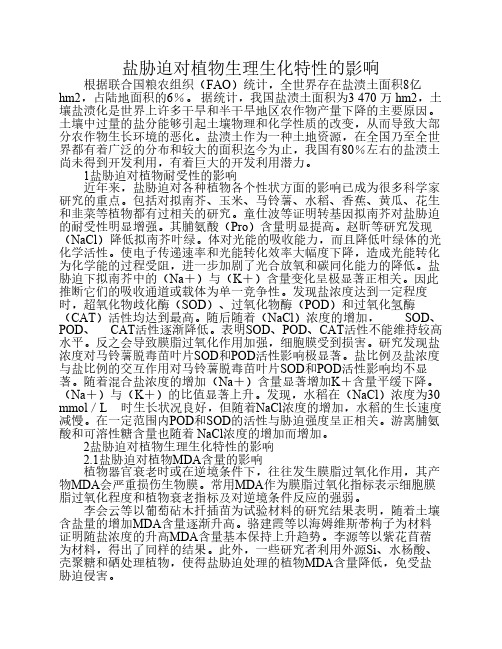
盐胁迫对植物生理生化特性的影响根据联合国粮农组织(FAO)统计,全世界存在盐渍土面积8亿hm2,占陆地面积的6%。
据统计,我国盐渍土面积为3 470 万 hm2,土壤盐渍化是世界上许多干旱和半干旱地区农作物产量下降的主要原因。
土壤中过量的盐分能够引起土壤物理和化学性质的改变,从而导致大部分农作物生长环境的恶化。
盐渍土作为一种土地资源,在全国乃至全世界都有着广泛的分布和较大的面积迄今为止,我国有80%左右的盐渍土尚未得到开发利用,有着巨大的开发利用潜力。
1盐胁迫对植物耐受性的影响近年来,盐胁迫对各种植物各个性状方面的影响已成为很多科学家研究的重点。
包括对拟南芥、玉米、马铃薯、水稻、香蕉、黄瓜、花生和韭菜等植物都有过相关的研究。
童仕波等证明转基因拟南芥对盐胁迫的耐受性明显增强。
其脯氨酸(Pro)含量明显提高。
赵昕等研究发现(NaCl)降低拟南芥叶绿。
体对光能的吸收能力,而且降低叶绿体的光化学活性。
使电子传递速率和光能转化效率大幅度下降,造成光能转化为化学能的过程受阻,进一步加剧了光合放氧和碳同化能力的降低。
盐胁迫下拟南芥中的(Na+)与(K+)含量变化呈极显著正相关。
因此推断它们的吸收通道或载体为单一竞争性。
发现盐浓度达到一定程度时,超氧化物歧化酶(SOD)、过氧化物酶(POD)和过氧化氢酶(CAT)活性均达到最高。
随后随着(NaCl)浓度的增加,SOD、POD、CAT活性逐渐降低。
表明SOD、POD、CAT活性不能维持较高水平。
反之会导致膜脂过氧化作用加强,细胞膜受到损害。
研究发现盐浓度对马铃薯脱毒苗叶片SOD和POD活性影响极显著。
盐比例及盐浓度与盐比例的交互作用对马铃薯脱毒苗叶片SOD和POD活性影响均不显著。
随着混合盐浓度的增加(Na+)含量显著增加K+含量平缓下降。
(Na+)与(K+)的比值显著上升。
发现,水稻在(NaCl)浓度为30 mmol/L 时生长状况良好,但随着NaCl浓度的增加,水稻的生长速度减慢。
低盐度对不同三疣梭子蟹群体幼蟹发育的影响
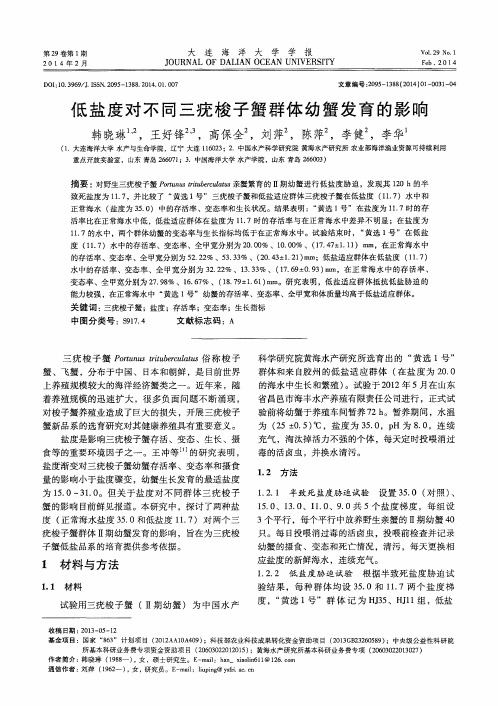
水 中的存活率 、变态率 、全 甲宽分别 为 3 2 . 2 2 % 、1 3 . 3 3 % 、( 1 7 . 6 9 ± O . 9 3 ) m m,在正 常海 水 中的存 活率 、 变态率 、全 甲宽分别为 2 7 . 9 8 %、1 6 . 6 7 % 、( 1 8 . 7 9 - - 1 . 6 1 ) m m。研究 表明 ,低盐适 应群体抵 抗低盐胁 迫 的 能力较强 ,在正常海水 中 “ 黄选 1 号” 幼蟹 的存活率 、变态率、全甲宽和体 质量均 高于低盐适应群体 。
科学研究院黄海水产研究所选育出的 “ 黄选 1 号” 群 体 和来 自胶州 的低 盐 适 应 群 体 ( 在盐度 为 2 0 . 0
的海水 中生 长 和繁殖 ) 。试验 于 2 0 1 2年 5月在 山东 省 昌邑市海 丰水产 养殖有 限责 任公 司进行 ,正 式试 验 前将 幼蟹 于养殖 车 间暂养 7 2 h 。暂 养期 间 ,水 温 为 ( 2 5± 0 . 5 ) ℃ ,盐 度 为 3 5 . 0 ,p H为 8 . 0 ,连 续 充 气 ,淘汰掉 活力 不强 的个体 ,每天 定时 投喂 消过 毒 的活 卤虫 ,并 换水 清污 。
第2 9卷第 1期
2 0 1 4年 2 月
大
连
海 洋 大
学 学 报
Vo 1 . 2 9 NO . 1
J 0UR NAL OF D AL I AN OC EA N UNI VE RS r r Y
F e b.20 1 4
D O I : l 0 . 3 9 6 9 / J . I S S N . 2 0 9 5 - 1 3 8 8 . 2 0 1 4 . 0 1 . 0 0 7
1 . 2 . 1 半 致死 盐度 胁迫试 验
水体盐度对三疣梭子蟹生长及存活的影响
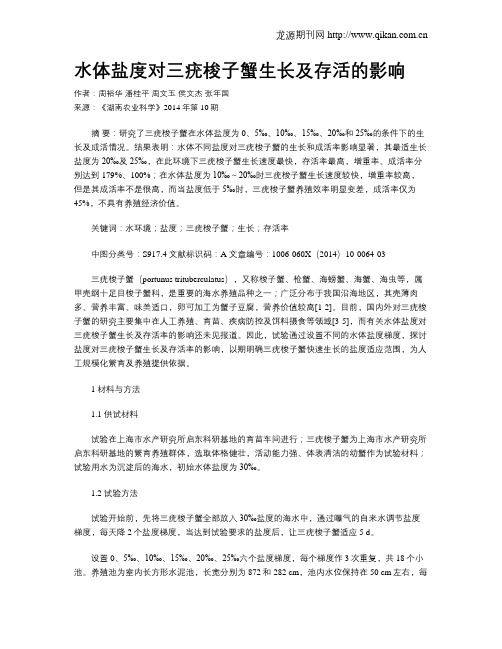
水体盐度对三疣梭子蟹生长及存活的影响作者:周裕华潘桂平周文玉侯文杰张年国来源:《湖南农业科学》2014年第10期摘要:研究了三疣梭子蟹在水体盐度为0、5‰、10‰、15‰、20‰和25‰的条件下的生长及成活情况。
结果表明:水体不同盐度对三疣梭子蟹的生长和成活率影响显著,其最适生长盐度为20‰及25‰,在此环境下三疣梭子蟹生长速度最快,存活率最高,增重率、成活率分别达到179%、100%;在水体盐度为10‰~20‰时三疣梭子蟹生长速度较快,增重率较高,但是其成活率不是很高,而当盐度低于5‰时,三疣梭子蟹养殖效率明显变差,成活率仅为45%,不具有养殖经济价值。
关键词:水环境;盐度;三疣梭子蟹;生长;存活率中图分类号:S917.4 文献标识码:A 文章编号:1006-060X(2014)10-0064-03三疣梭子蟹(portunus trituberculatus),又称梭子蟹、枪蟹、海螃蟹、海蟹、海虫等,属甲壳纲十足目梭子蟹科,是重要的海水养殖品种之一;广泛分布于我国沿海地区,其壳薄肉多、营养丰富、味美适口,卵可加工为蟹子豆腐,营养价值较高[1-2]。
目前,国内外对三疣梭子蟹的研究主要集中在人工养殖、育苗、疾病防控及饵料摄食等领域[3-5],而有关水体盐度对三疣梭子蟹生长及存活率的影响还未见报道。
因此,试验通过设置不同的水体盐度梯度,探讨盐度对三疣梭子蟹生长及存活率的影响,以期明确三疣梭子蟹快速生长的盐度适应范围,为人工规模化繁育及养殖提供依据。
1 材料与方法1.1 供试材料试验在上海市水产研究所启东科研基地的育苗车间进行;三疣梭子蟹为上海市水产研究所启东科研基地的繁育养殖群体,选取体格健壮,活动能力强、体表清洁的幼蟹作为试验材料;试验用水为沉淀后的海水,初始水体盐度为30‰。
1.2 试验方法试验开始前,先将三疣梭子蟹全部放入30‰盐度的海水中,通过曝气的自来水调节盐度梯度,每天降2个盐度梯度,当达到试验要求的盐度后,让三疣梭子蟹适应5 d。
盐度胁迫对锯缘青蟹体内腺苷三磷酸酶和磷酸酶活性的影响
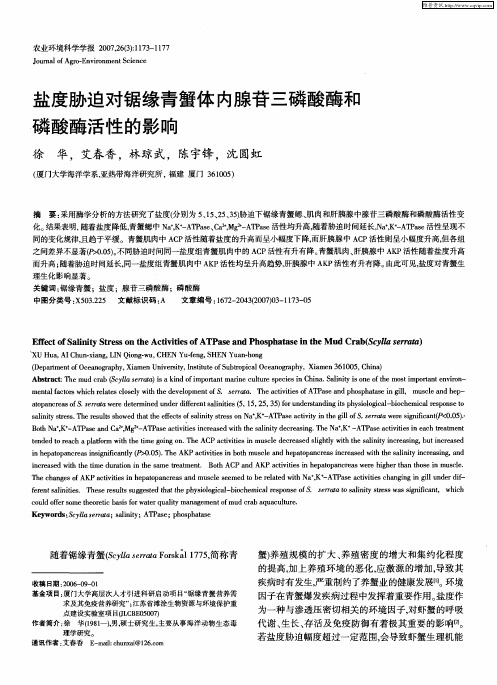
关键词 : 锯缘青蟹 ;盐度 ;腺苷三磷酸 酶;磷酸酶
中图分 类号 : 5 32 5 文献标识码 : X 0. 2 A 文章编号 :6 2 2 4 (0 70 — 13 0 17 — 0 3 0 )3 17 — 5 2
E et f aii tes nteA t i e f P s n h s h ts eMu r bSyl raa f c l t Srs ci t s oS n y o h v i o AT aea dP op aa e nt dC a (c l s rt1 i h a e
a pn r s f r t eedt mie n e d f e ta nts5 1, 5 3 )o n e t d g tpyi oi lbohmi lepne o t a c a s r a r e r ndu dr ie n iie (, 5 2 , 5fr dr a i s h s lg a— i e c so s o e oS e a w e fr s l i u s n n i o c c ar t s ii rs. h sl o e a te f c ii rs o a. A Ps cit i te lo sr t w r s n c t < .5・ l yt ant s esT e euts w dh th f tos nt s es nN - T ae t i l f .er a ee i i a ( 00 ) r sh t ee s a y t f l K a v nhg S y i a g fn P i .
B t N + +A P s d a ' A P s t ie ce sdw t te ai t d ce s g T e a, A P s c vt s nec e t n o a K - T ae zMg 一 T ae ci t s n rae i l i e rai .  ̄ 一 T aea t i e ht a h , n a C + a vi i hh s ny n h N K i i i a r me t
温度胁迫对三疣梭子蟹血清中非特异性免疫因子的影响

磷 酸酶 ( K ) 和酸性磷酸酶 ( C )活力的变化 。结果表 明 :温度骤变后 ,筛 选蟹 G S和普 通蟹 R AP AP S的 血 蓝蛋 白含量在 3h时均达到峰值 ( 0 0 ) P< . 5 ,随后 又逐渐下降 ,到 3~1 2h时已基本恢复到 0h的水平 ( P > . 5 。两组蟹 的 S D和 A P在低温 、高温胁迫 3h内也均显著下降 ( 0 0 ) 00 ) O K P< .5 ,到 3~1 2 h达到稳定 的低水平 ( P>00 ) .5 ;在温度骤变 的胁迫下 ,P D、C T和 A P活力随时间变化也基本呈峰值变化 ,但达 O A C 到峰值和趋于稳定 的时间不具同步性。方差 分析结果显示 ,筛选蟹 G S的免疫指标值均显著高于普通蟹 R 2 S ( 00) P< .5 ,说明筛选蟹 G 比普通蟹 R : S在非特异 性免疫 因子方面更具免 疫优势 。以上 结果表 明:温度骤 变的短期胁迫会影 响机体的生理功能 和机体 的免疫 防御能力 ,导致 自由基代谢紊乱 ,从而诱导病 害发生 。
( 04 2 2 ;宁波 市 重 大 招标 项 目 (0 8 10 1 20 109) 2 0 C 10 ) 作 者 简 介 : 丹华 ( 93一) 吴 18 ,女 ,硕 士研 究 生 。 E—ma : u ah a2 @ 13 CB i w dn u 13 6 .O l 通 信作 者 :王 春琳 (9 3一) 16 ,男 ,教 授 。 E— i: agh ni@ nu eu c ma w n cu l l n b. d. n
温 度胁 迫对 三疣 梭 子 蟹血 清 中非特 异 性
免 疫 因 子 的 影 响
吴 丹 华 ,郑 萍 萍 ,张玉 玉 ,王 春 琳
( 宁波 大 学 省 部 共建 “ 用 海 洋 生 物 技术 ” 教 育 部 重点 实 验 室 ,浙 江 宁 波 3 5 1 ) 应 12 1
盐度对三疣梭子蟹摄食行为及生长特性的影响

盐度对三疣梭子蟹摄食行为及生长特性的影响丁张妮;徐永健;林建华;李景;张桂华【期刊名称】《生态科学》【年(卷),期】2014(033)005【摘要】从行为角度出发,设置了5、10、20、30和40五个盐度梯度,探讨不同盐度对梭子蟹幼蟹和成蟹的摄食行为及特性的影响.结果表明:在盐度5时,除摄食活动外,幼蟹不外出游动且深潜底沙(约0.5 cm);在盐度40时,幼蟹浅潜沙层,仅盖住背甲(约0.1 cm);盐度为10、20和30时,除觅食活动外,幼蟹均外出游动.日摄食次数由幼蟹的1-2次增加到成蟹的2-4次.盐度为10-40时,幼蟹平均日摄食量均维持在0.0999 g·g-1以上(每天每只梭子蟹单位体重所摄取食物的重量,下同),其中盐度为20时的日摄食量为最大(0.1974 g·g-1),幼蟹生长的适宜盐度范围为10-40,最适为20.此外,各盐度对成蟹的行为压迫不大,对应的日平均摄食量亦无显著差别.【总页数】5页(P899-903)【作者】丁张妮;徐永健;林建华;李景;张桂华【作者单位】宁波大学海洋学院/应用海洋生物技术教育部重点实验室,宁波315211;宁波大学海洋学院/应用海洋生物技术教育部重点实验室,宁波315211;宁波大学海洋学院/应用海洋生物技术教育部重点实验室,宁波315211;宁波市象山县新桥镇农办,宁波315726;宁波大学海洋学院/应用海洋生物技术教育部重点实验室,宁波315211;宁波大学海洋学院/应用海洋生物技术教育部重点实验室,宁波315211【正文语种】中文【中图分类】S969.3【相关文献】1.食物资源不足条件下螯足数量对三疣梭子蟹(Portunus trituberculatus)摄食行为和种内竞食能力的影响 [J], 何杰;王绪杰;余方平;许文军;谢建军;王庚申;汪玮;施慧2.砂粒粒径与砂层厚度对单体筐养养殖系统中三疣梭子蟹(Portunus trituberculatus)幼蟹摄食行为与生长特性的影响研究 [J], 徐永健;申屠基康;丁张妮3.饲养空间大小对单体筐养养殖系统中三疣梭子蟹(Portunus trituberculatus)的摄食行为与生长特性的影响研究 [J], 徐永健;申屠基康;丁张妮4.盐度胁迫对三疣梭子蟹肌肉和血淋巴中游离氨基酸含量的影响 [J], 付萍;吕建建;刘萍;李健;高保全5.水体盐度对雌性三疣梭子蟹生长、卵巢发育、渗透压调节、代谢和抗氧化能力的影响 [J], 龙晓文;吴仁福;侯文杰;潘桂平;成永旭;吴旭干因版权原因,仅展示原文概要,查看原文内容请购买。
海水养殖梭子蟹苗的胁迫适应机制研究
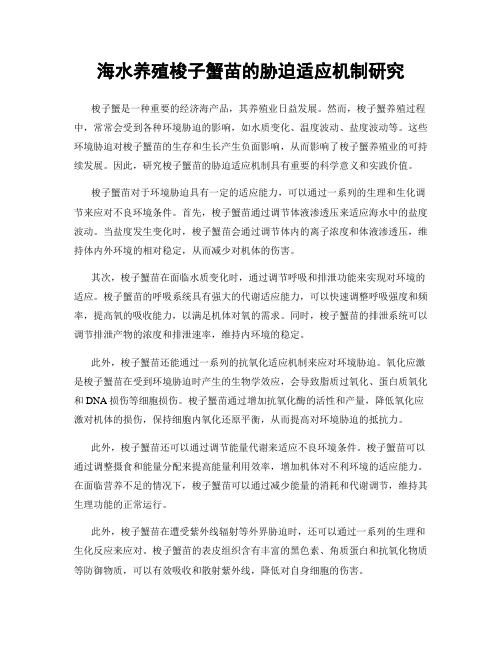
海水养殖梭子蟹苗的胁迫适应机制研究梭子蟹是一种重要的经济海产品,其养殖业日益发展。
然而,梭子蟹养殖过程中,常常会受到各种环境胁迫的影响,如水质变化、温度波动、盐度波动等。
这些环境胁迫对梭子蟹苗的生存和生长产生负面影响,从而影响了梭子蟹养殖业的可持续发展。
因此,研究梭子蟹苗的胁迫适应机制具有重要的科学意义和实践价值。
梭子蟹苗对于环境胁迫具有一定的适应能力,可以通过一系列的生理和生化调节来应对不良环境条件。
首先,梭子蟹苗通过调节体液渗透压来适应海水中的盐度波动。
当盐度发生变化时,梭子蟹苗会通过调节体内的离子浓度和体液渗透压,维持体内外环境的相对稳定,从而减少对机体的伤害。
其次,梭子蟹苗在面临水质变化时,通过调节呼吸和排泄功能来实现对环境的适应。
梭子蟹苗的呼吸系统具有强大的代谢适应能力,可以快速调整呼吸强度和频率,提高氧的吸收能力,以满足机体对氧的需求。
同时,梭子蟹苗的排泄系统可以调节排泄产物的浓度和排泄速率,维持内环境的稳定。
此外,梭子蟹苗还能通过一系列的抗氧化适应机制来应对环境胁迫。
氧化应激是梭子蟹苗在受到环境胁迫时产生的生物学效应,会导致脂质过氧化、蛋白质氧化和DNA损伤等细胞损伤。
梭子蟹苗通过增加抗氧化酶的活性和产量,降低氧化应激对机体的损伤,保持细胞内氧化还原平衡,从而提高对环境胁迫的抵抗力。
此外,梭子蟹苗还可以通过调节能量代谢来适应不良环境条件。
梭子蟹苗可以通过调整摄食和能量分配来提高能量利用效率,增加机体对不利环境的适应能力。
在面临营养不足的情况下,梭子蟹苗可以通过减少能量的消耗和代谢调节,维持其生理功能的正常运行。
此外,梭子蟹苗在遭受紫外线辐射等外界胁迫时,还可以通过一系列的生理和生化反应来应对。
梭子蟹苗的表皮组织含有丰富的黑色素、角质蛋白和抗氧化物质等防御物质,可以有效吸收和散射紫外线,降低对自身细胞的伤害。
总之,梭子蟹苗在面临环境胁迫时,通过一系列的生理和生化调节来适应不良环境条件。
三疣梭子蟹肌肉组织中甜菜碱、糖原及无机盐变化研究
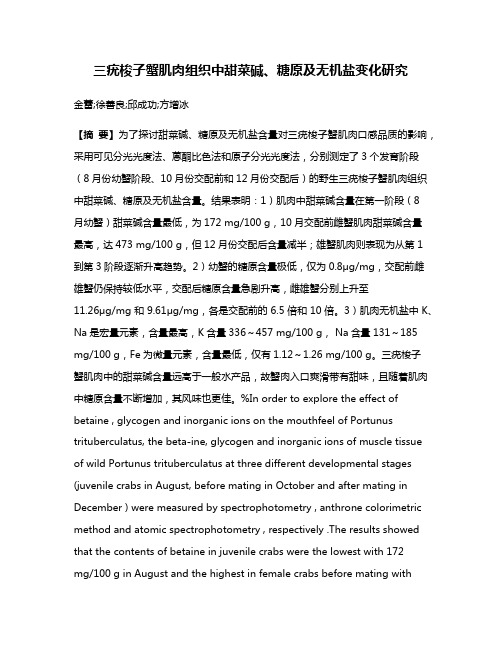
三疣梭子蟹肌肉组织中甜菜碱、糖原及无机盐变化研究金蕾;徐善良;邱成功;方增冰【摘要】为了探讨甜菜碱、糖原及无机盐含量对三疣梭子蟹肌肉口感品质的影响,采用可见分光光度法、蒽酮比色法和原子分光光度法,分别测定了3个发育阶段(8月份幼蟹阶段、10月份交配前和12月份交配后)的野生三疣梭子蟹肌肉组织中甜菜碱、糖原及无机盐含量。
结果表明:1)肌肉中甜菜碱含量在第一阶段(8月幼蟹)甜菜碱含量最低,为172 mg/100 g,10月交配前雌蟹肌肉甜菜碱含量最高,达473 mg/100 g,但12月份交配后含量减半;雄蟹肌肉则表现为从第1到第3阶段逐渐升高趋势。
2)幼蟹的糖原含量极低,仅为0.8μg/mg,交配前雌雄蟹仍保持较低水平,交配后糖原含量急剧升高,雌雄蟹分别上升至11.26μg/mg和9.61μg/mg,各是交配前的6.5倍和10倍。
3)肌肉无机盐中K、Na是宏量元素,含量最高,K含量336~457 mg/100 g, Na含量131~185 mg/100 g,Fe为微量元素,含量最低,仅有1.12~1.26 mg/100 g。
三疣梭子蟹肌肉中的甜菜碱含量远高于一般水产品,故蟹肉入口爽滑带有甜味,且随着肌肉中糖原含量不断增加,其风味也更佳。
%In order to explore the effect of betaine , glycogen and inorganic ions on the mouthfeel of Portunus trituberculatus, the beta-ine, glycogen and inorganic ions of muscle tissue of wild Portunus trituberculatus at three different developmental stages (juvenile crabs in August, before mating in October and after mating in December ) were measured by spectrophotometry , anthrone colorimetric method and atomic spectrophotometry , respectively .The results showed that the contents of betaine in juvenile crabs were the lowest with 172mg/100 g in August and the highest in female crabs before mating with473 mg/100 g in October , but after mating , the contents of be-taine in female crabs halved;the contents of betaine in the male cr abs′muscles increased gradually with the growth .The contents of glycogen in juvenile crabs were very low , just 0.8μg/mg.The glycogen of male and female crabs kept a lower level before mating , but increased rapidly after mating , the contents of glycogen in male and female crabs rose to 11.26 μg/mg and 9.61μg/mg, respectively. The elements of K and Na were macroelement and were highest in inorganic ions of muscles , the content of K was 336-457 mg/100 g, and the content of Na was 131-185 mg/100 g;Fe was microelement , only 1.12-1.26 mg/100 g.【期刊名称】《生物学杂志》【年(卷),期】2014(000)004【总页数】5页(P24-28)【关键词】三疣梭子蟹;甜菜碱;糖原;无机盐;营养品质【作者】金蕾;徐善良;邱成功;方增冰【作者单位】宁波大学科学技术学院,浙江宁波315211;宁波大学应用海洋生物技术教育部重点实验室,浙江宁波315211;宁波大学应用海洋生物技术教育部重点实验室,浙江宁波315211;宁波大学应用海洋生物技术教育部重点实验室,浙江宁波315211【正文语种】中文【中图分类】S963.16+1三疣梭子蟹(Portunus trituberculatus)简称“梭子蟹”,北方俗称“篮蟹”、“螃蟹”,南方称“白蟹”、“膏蟹”,浙南称“江蟹”,是一种大型海洋经济食用蟹类。
盐胁迫对植物体内游离脯氨酸积累的影响.doc
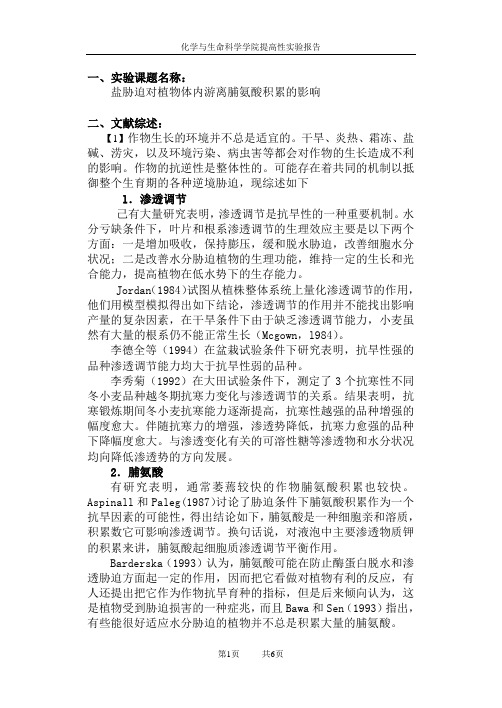
一、实验课题名称:盐胁迫对植物体内游离脯氨酸积累的影响二、文献综述:【1】作物生长的环境并不总是适宜的。
干旱、炎热、霜冻、盐碱、涝灾,以及环境污染、病虫害等都会对作物的生长造成不利的影响。
作物的抗逆性是整体性的。
可能存在着共同的机制以抵御整个生育期的各种逆境胁迫,现综述如下l.渗透调节己有大量研究表明,渗透调节是抗旱性的一种重要机制。
水分亏缺条件下,叶片和根系渗透调节的生理效应主要是以下两个方面:一是增加吸收,保持膨压,缓和脱水胁迫,改善细胞水分状况;二是改善水分胁迫植物的生理功能,维持一定的生长和光合能力,提高植物在低水势下的生存能力。
Jordan(1984)试图从植株整体系统上量化渗透调节的作用,他们用模型模拟得出如下结论,渗透调节的作用并不能找出影响产量的复杂因素,在干旱条件下由于缺乏渗透调节能力,小麦虽然有大量的根系仍不能正常生长(Mcgown,l984)。
李德全等(1994)在盆栽试验条件下研究表明,抗旱性强的品种渗透调节能力均大于抗旱性弱的品种。
李秀菊(1992)在大田试验条件下,测定了3个抗寒性不同冬小麦品种越冬期抗寒力变化与渗透调节的关系。
结果表明,抗寒锻炼期间冬小麦抗寒能力逐渐提高,抗寒性越强的品种增强的幅度愈大。
伴随抗寒力的增强,渗透势降低,抗寒力愈强的品种下降幅度愈大。
与渗透变化有关的可溶性糖等渗透物和水分状况均向降低渗透势的方向发展。
2.脯氨酸有研究表明,通常萎蔫较快的作物脯氨酸积累也较快。
Aspinall和Paleg(1987)讨论了胁迫条件下脯氨酸积累作为一个抗旱因素的可能性,得出结论如下,脯氨酸是一种细胞亲和溶质,积累数它可影响渗透调节。
换句话说,对液泡中主要渗透物质钾的积累来讲,脯氨酸起细胞质渗透调节平衡作用。
Barderska(1993)认为,脯氨酸可能在防止酶蛋白脱水和渗透胁迫方面起一定的作用,因而把它看做对植物有利的反应,有人还提出把它作为作物抗旱育种的指标,但是后来倾向认为,这是植物受到胁迫损害的一种症兆,而且Bawa和Sen(1993)指出,有些能很好适应水分胁迫的植物并不总是积累大量的脯氨酸。
- 1、下载文档前请自行甄别文档内容的完整性,平台不提供额外的编辑、内容补充、找答案等附加服务。
- 2、"仅部分预览"的文档,不可在线预览部分如存在完整性等问题,可反馈申请退款(可完整预览的文档不适用该条件!)。
- 3、如文档侵犯您的权益,请联系客服反馈,我们会尽快为您处理(人工客服工作时间:9:00-18:30)。
盐度胁迫对三疣梭子蟹肌肉和血淋巴中游离氨基酸含量的影响付萍;吕建建;刘萍;李健;高保全【摘要】Salinity is one of the most important factors influencing distribution,abundance and the physiology of aquatic animals.Changes in ambient salinity are directly related to osmoregulation capacity.During acclimation to salinity,the main challenge for aquatic animals is to regulate their osmotic pressure to maintain normal life activities.As the predominant aquatic animal,crustaceans can dwell in seawater and flesh water due to their various osmoregulatory mechanisms.The two forms of osmoregulatory mechanisms are anisosmotic extracellular regulation (AER) and intracellular isosmotic regulation (ⅡR).AER can mainly control the osmolality of the body fluid through regulation of gills and antennal glands,while ⅡR maintains intracellular osmolality and maintain the balance between tissues and the hemolymph primarily by regulating amino acids (FAAs) especially non-essential amino acids (NEAA).Under excessive changes in environmental salinity,it's difficult for body fluid osmolality to be maintained at a completely stable level through AER.At that point,it's believed that ⅡR compensates for AER by accumulating or degrading some particular NEAA as osmolytes,effectivley moderating fluctuations in extracellular osmolality and facilitating volume readjustment.Hemolymph is directly involved in responding to salinity exposure and muscle is the major tissue for protein deposition and possibly represents the main pool of amino acids.Therefore muscle tissueand hemolymph are very important to study FAAs's involvement in osmotic pressure regulation.The experiment analyses the free amino acids content and concentration variation in muscle and hemolymph of Portunus trituberculatus at different salinities.Clarify the composition of FAAs and its function in the salinity adaptation.Enrich the FAAs in the field of salinity adaptation and provide the basis for further study of the molecular mechanism.The contents of FAAs were measured at salinities and the experiment lasted for 5 days.Determination of FAAs extraction solution of muscle and hemolymph with Hitachi 835-50 automatic amino acid analyzer.Results showed that the highest amounts of individual FAA in seawater-adapted P.trituberculatus was exhibited by Tauine,Arg,Gly,Pro and Ala.As salinity increased,the total flee amino acids (TOFAA) of the hemolymph and muscle increased significantly.NEAA increased significantly when the salinity varied from 10 to 50 while Essential FAA (EAA) was not affected by external salinity change.The result showed that FAAs played an important role in salinity adaptation,especiallyPro,Ala,Gly,Asp and Glu.Because Ala,Gly,Asp,Glu belong to the taste amino acids (TAA),so TAA played an important role in osmoregulation.The content of Pro increased significantly both in muscle and hemolymph,especially from 40 to 50 period.Therefore Pro played the most important role in hyperosmotic stress.%为探究不同盐度环境下三疣梭子蟹肌肉和血淋巴中游离氨基酸(free amino acids,FAAs)的含量及浓度的变化规律,明确FAAs的组成以及在盐度适应中发挥的作用,丰富FAAs在甲壳动物盐度适应领域的研究,为后续分子机理的研究提供依据,实验设定胁迫盐度分别为10、20、40、50,以正常海水(盐度33)为对照,用日立835-50型氨基酸自动分析仪测定三疣梭子蟹血淋巴与肌肉组织中游离氨基酸的组分,分析不同盐度环境下三疣梭子蟹肌肉和血淋巴中FAAs的含量及变化规律.结果显示,在正常海水中三疣梭子蟹血淋巴和肌肉中含量较高的FAAs主要为牛磺酸(Tau)、精氨酸(Arg)、甘氨酸(Gly)、脯氨酸(Pro)和丙氨酸(Ala).盐度为10~50,梭子蟹肌肉和血淋巴总游离氨基酸(total free amino acid,TOFAA)的含量随盐度的增加而显著升高,非必需氨基酸(non-essentical free amino acid,NEAA)的含量随盐度的升高而上升,而必需氨基酸(essentical free amino acid,EAA)的含量变化不显著,因此,TOFAA在渗透压调节方面的作用主要取决于NEAA.发挥主要渗透压调节作用的FAAs为脯氨酸(Pro)、丙氨酸(Ala)、甘氨酸(Gly)、天冬氨酸(Asp)、谷氨酸(Glu).Ala、Gly、Asp、Glu 属于鲜味氨基酸(taste amino acid,TAA),研究表明,NEAA中的TAA在渗透压调节方面作用显著,Pro含量的升高对TOFAA含量的增加作用显著,盐度为40~50尤甚,表明Pro在梭子蟹高渗调节中发挥重要作用.【期刊名称】《水产学报》【年(卷),期】2017(041)003【总页数】8页(P374-381)【关键词】三疣梭子蟹;血淋巴;肌肉;盐度;非必需氨基酸(NEAA);鲜味氨基酸(TAA);脯氨酸(Pro)【作者】付萍;吕建建;刘萍;李健;高保全【作者单位】中国水产科学研究院黄海水产研究所,山东青岛266071;大连海洋大学水产与生命学院,辽宁大连116023;青岛海洋科学与技术国家实验室海洋渔业科学与食物产出过程功能实验室,山东青岛266200;中国水产科学研究院黄海水产研究所,山东青岛266071;青岛海洋科学与技术国家实验室海洋渔业科学与食物产出过程功能实验室,山东青岛266200;中国水产科学研究院黄海水产研究所,山东青岛266071;青岛海洋科学与技术国家实验室海洋渔业科学与食物产出过程功能实验室,山东青岛266200;中国水产科学研究院黄海水产研究所,山东青岛266071;青岛海洋科学与技术国家实验室海洋渔业科学与食物产出过程功能实验室,山东青岛266200;中国水产科学研究院黄海水产研究所,山东青岛266071;青岛海洋科学与技术国家实验室海洋渔业科学与食物产出过程功能实验室,山东青岛266200【正文语种】中文【中图分类】S968.2在自然界中,动物的生活环境是复杂多变的,和其他水生生物一样,在诸多变化的水化学因子中,盐度是影响甲壳动物生理状态的重要因子之一[1-3]。
随着生存环境中盐度的改变,在神经内分泌系统的调控下,渗透调节器官的结构、血淋巴渗透压和离子转运等都会发生一系列变化以适应外界环境的盐度变化[4],因此对甲壳动物而言在适应不同的盐度环境时最重要的是调节机体的渗透压以维持正常的生命活动[5]。
甲壳动物主要依靠两种形式的渗透压调节机制即非等渗细胞外调节(anisosmotic extracellular regulation,AER)和等渗细胞内调节(intracellular isosmotic regulation,IIR)[6]。
